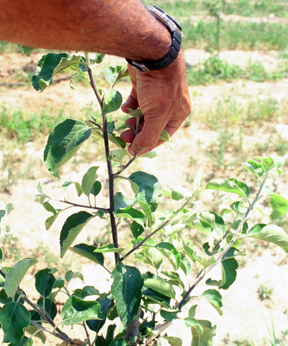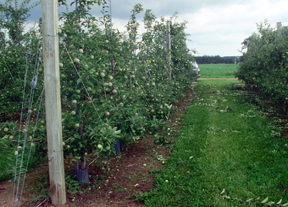Summer pruning apples
Editor’s note: This article is from the archives of the MSU Crop Advisory Team Alerts. Check the label of any pesticide referenced to ensure your use is included.
Note: This was originally printed in the May 2009 Fruit Growers’ News, 48:5, 1 & 2.
There are many elements, pro and con, that go into the decision to summer prune apples. There are some rules for applying this practice to make it a positive experience; otherwise the grower may see some negative results. Considerable research has been conducted over the years and there are some excellent references on the subject that can help shed light on the subject. One reference on the topic is a paper-back book Training and Pruning Apple and Pear Trees authored by C. Forshey, D. Elfving and R. Stebbins, published in 1992 by the American Society for Hort Science, 166 pages (now out of print).
In this article, I will try to systematically discuss some of the primary issues related to summer pruning. Remember that summer pruning alone is not to be followed if the grower is expecting positive results. It can be very effective when used in supplement to dormant pruning with good timing. Summer pruning is very effective in controlling growth and removing unwanted growth on young developing trees. In fact, it is very effective in early summer such as pinching of strong laterals in the upper regions of the Central Leader, Vertical Axe or Slender Spindle trees if your intention is to maintain a strong growing leader (see Photo 1). Realize that if done too early (prior to when laterals are six inches of growth) that re-growth is possible, so waiting until mid-July to avoid a second pinching. In all cases, whether young or mature orchard, wait until the prime fire blight conditions are past before attempting. I have actually spread fire blight among young trees by not waiting until the weather was dry and hot.
Summer pruning of mature trees
Removing growth during the summer to open canopies to allow more light and improve fruit color is effective. It is possible to not see an improvement in fruit color with pruning under warm, humid fruit development conditions. There is some potential for sunburn, but in our climate is less of a problem than in the west. Remember that it needs to be accomplished prior to four weeks before harvest. Therefore, this should be done late July in Michigan. Pruning for this purpose can be a trade-off, as a grower will see a reduction in fruit size, especially if done late (approaching harvest). It is also possible to see a reduction in yield and soluble solids. Any summer pruning should be accomplished after the apical bud sets. If shoots are removed prior to terminal bud set, expect to see regrowth near cuts. Excessive early pruning can also reduce conversion of shoots into spurs, and delay or inhibit flower bud initiation. Watersprouts can be removed anytime, especially in the early part of summer. Watersprouts have a tendency to shade canopy interiors and draw calcium away from fruit and aggravating bitter pit problems.
Summer pruning can not make up for excessive crowding associated with vigorous conditions or selection of vigorous rootstocks for the spacing (see image of M.9 VS B.9).
Summer pruning can be very effective when managing high density plantings if accomplished at the right time. One of the benefits of summer pruning is that there is less compensatory growth in response to cuts as long as it is performed in a moderate way (avoid excessive summer pruning). It is possible to summer prune after the terminal bud has set to inhibitive lateral shoot extension and impending encroachment on neighboring trees or alleyways (see Photo 2). This can be done by making a thinning cut back to a weak lateral or fruit spur. Additionally, this is also the best time if the trees are getting too tall. Although you may remove some fruit, making a thinning cut mid- to late summer back to a lateral bearing fruit can lower canopy height and avoid shading on neighboring tree rows. Lowering tree canopy during summer lessens the chance for compensatory top growth as compared to this operation performed in winter. In visiting a Tall Spindle orchard in western New York, this past summer, one grower had developed a sickle bar hedger to “summer-sheer” the sides of his canopy to maintain a narrow canopy and reduce the amount of pruning time/labor during winter. The practice appears economically feasible and effective in his operation. Careful follow-up hand pruning in the winter is advised anytime mechanical devices are deployed and cut in arbitrary planes of dimension. Many growers who have Super Slender Spindle plantings do the bulk of branch removal during the summer to remove unwanted strong growth and avoid compensatory strong growth in response, commonly experienced in winter pruning.
Summer pruning can be a very effective tool in the right hands and deployed at the right time. Be aware of pitfalls that go along with the benefits.



 Print
Print Email
Email





